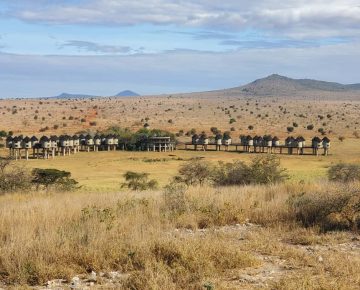Central Island National Park
Central Island National Park is a unique and captivating destination nestled in the heart of Lake Turkana. It is often referred to as the “Jade Sea” because of its stunning turquoise waters. This remote park, established in 1985, covers an area of approximately 7.5 square kilometers and is renowned for its volcanic landscapes, diverse wildlife, and rich cultural heritage. Central Island stands out not just for its natural beauty but also for its significance as a sanctuary for various species, including the endangered Nile crocodile.
Historical Background of Central Island National Park
Central Island has a fascinating history that intertwines with the geological and cultural narratives of the region. Formed by volcanic activity, the island is home to three craters that are remnants of past eruptions. The island’s strategic location in Lake Turkana has made it an important site for various communities over the centuries, including the local Turkana people, who have traditionally relied on the lake’s resources for survival.
Cultural Significance
The Turkana community plays a significant role in the cultural tapestry of the region. Their rich traditions, nomadic lifestyle, and deep connection to the land and water have shaped the island’s cultural landscape. Visitors to Central Island can engage with the local communities, learning about their customs, crafts, and way of life, which are intricately tied to the rhythms of the lake.

Geographical Features in Central Island National Park
Volcanic Landscape
Central Island is characterized by its striking volcanic features, including three prominent craters: the largest, known as the “Main Crater,” is approximately 1.5 kilometers wide. The craters are surrounded by steep cliffs that offer breathtaking views of the lake and surrounding landscapes. The island’s rugged terrain, combined with the shimmering blue waters of Lake Turkana, creates a dramatic and picturesque setting.
Biodiversity
The unique microclimate of Central Island supports a diverse range of flora and fauna. The park is home to several endemic species, including the Turkana tilapia, a fish species that thrives in the lake’s warm waters. The island’s vegetation primarily consists of acacia trees, shrubs, and grasses, creating habitats for various wildlife.
Nile Crocodiles
One of the park’s most notable inhabitants is the Nile crocodile, which finds refuge on Central Island’s shores. The island serves as a breeding ground for these reptiles, and visitors can often observe them basking in the sun or swimming in the lake. The crocodile population is crucial for maintaining the ecological balance of the area, as they play a significant role in controlling fish populations.
Birdlife
Central Island is a birdwatcher’s paradise, boasting over 100 recorded bird species. The diverse habitats within the park provide nesting sites for both resident and migratory birds. Notable species include the African fish eagle, herons, and various species of waterfowl. Birdwatching enthusiasts can enjoy the sights and sounds of these beautiful creatures throughout the year.
In addition to crocodiles and birds, Central Island is home to a variety of other wildlife, including small mammals and reptiles. While large mammals are less common, visitors may encounter species like the rock hyrax or different types of rodents. The island’s ecosystems are interconnected, and each species contributes to the overall health of the environment.
Activities and Adventures in Central Island National Park
Hiking and Exploration
Central Island offers visitors a chance to explore its volcanic craters and rugged terrain through guided hikes. Ascending to the rim of the craters provides breathtaking panoramic views of Lake Turkana and the surrounding landscapes. The trails vary in difficulty, making it accessible for both avid hikers and casual explorers.
Birdwatching
For bird enthusiasts, the island is a prime location for observing a variety of avian species. Birdwatching tours are available, offering expert guidance and insights into the behaviors and habitats of the local birdlife. Early morning or late afternoon excursions are particularly rewarding, as birds are most active during these times.
Fishing
Lake Turkana is known for its rich aquatic life, and fishing is a popular activity for visitors. Engaging with local fishermen, visitors can learn traditional fishing techniques and experience the lake’s bounty firsthand. Sustainable fishing practices are encouraged to help preserve the delicate ecosystem of the lake.
Cultural Interactions
Interacting with the Turkana people provides a unique cultural experience. Visitors can participate in community activities, such as traditional dances, storytelling, and craft-making. These experiences foster a deeper understanding of the local culture and enhance the overall visit.
Conservation Efforts in Central Island National Park
Protecting Biodiversity
Central Island National Park plays a critical role in conserving the unique biodiversity of the region. Efforts are underway to protect the habitats of endangered species, particularly the Nile crocodile. Conservation programs aim to monitor populations, reduce human-wildlife conflict, and promote sustainable tourism practices.
Community Engagement
The involvement of local communities in conservation initiatives is vital for the park’s success. Community-based programs educate residents about the importance of preserving their natural resources and creating sustainable livelihoods through eco-tourism. Collaborating with local communities ensures that they benefit from the park while actively participating in its conservation.
Getting there
Central Island National Park is accessible primarily by boat from various points around Lake Turkana, with the most common departure point being the town of Loiyangalani. The journey offers stunning views of the lake and the surrounding landscape, setting the stage for the adventure ahead.
Best time to Visit
The best time to visit Central Island is during the dry season, from June to October, when temperatures are more manageable and wildlife is more easily spotted. However, the island’s unique beauty can be appreciated year-round, each season offering its own distinct charm.
Accommodation
While there are no formal lodges within Central Island National Park, visitors can find accommodation options in nearby Loiyangalani, ranging from budget guesthouses to more upscale lodges. Camping is also an option for those looking to immerse themselves in nature.
Central Island National Park is a hidden gem in Kenya that offers a unique blend of breathtaking landscapes, rich biodiversity, and vibrant cultural experiences. With its stunning volcanic features, diverse wildlife, and opportunities for adventure, the park is a must-visit destination for nature lovers and cultural enthusiasts alike. Whether you’re hiking to the rim of a crater, observing the fascinating wildlife, or engaging with the local Turkana community, Central Island promises an unforgettable experience. As conservation efforts continue, the hope is that this remarkable destination will remain a sanctuary for both wildlife and visitors for generations to come.















